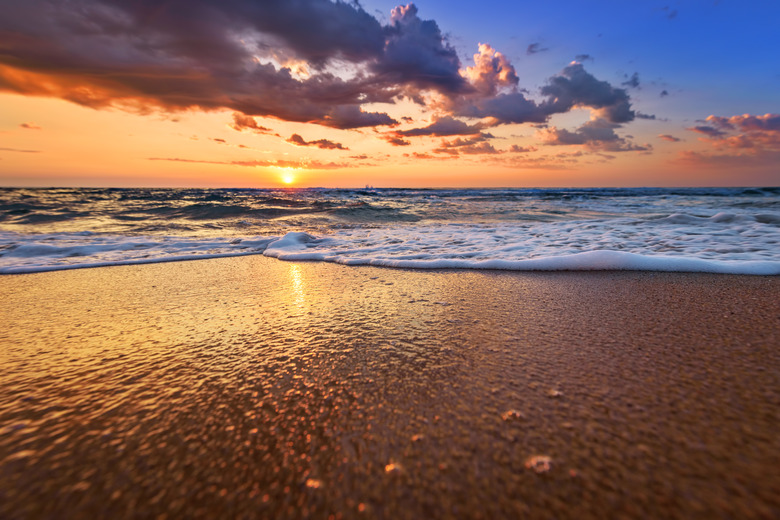How To Use Lightning Rods On A Beach To Make Glass
A character in the movie "Sweet Home Alabama," uses the lightning at a beach to transform sand into intricate and delicate glass sculptures. He attracts lightning by using lightning rods stuck into the sand. When lightning strikes, the bolt of extreme heat melts the sand and instantaneously forms a twisted, branching piece of clear, shining glass. While it is true that lightning can and does melt sand to form glass sculptures that resemble tree branches, the movie's portrayal of how this happens is not accurate.
Although this phenomenon happens everywhere in the world where sand is present, it is rare and has never been triggered by a person on a beach with a lightning rod. This should not be attempted. Part of the reason for this is because lightning is unpredictable, and part is because it is extremely dangerous to go near a beach or other unsheltered place during a lightning storm. The glass formed by lightning striking sand is called a fulgurite, and it looks very different from the glass sculptures in "Sweet Home Alabama."
TL;DR (Too Long; Didn't Read)
Lightning is unpredictable and extremely dangerous. If lightning strikes dry silica sand that is free of clay silt, the heat can cause the sand to melt instantaneously and fuse into a glass structure called a fulgurite. Fulgurites are usually 1 to 2 inches in diameter and 2 feet or more in length. Their exterior is a hard, crumbly, gray or brown texture, which is coated in partially melted grains of sand. The inside is a translucent, clear or whitish glass tube.
Scientists have completed several successful attempts to trigger lightning to create fulgurites, using methods that required rockets, buried electrical cables, months of work, and a great deal of collaboration. Other than this handful of successful trials, no humans have ever artificially triggered lightning to make fulgurites, especially individuals with lightning rods on beaches.
The Real Glass Sculptures
The Real Glass Sculptures
Lightning typically reaches 2,500 degrees Fahrenheit. Since fulgurites can be made with a source of heat that is 1,800 degrees, lightning more than suffices. They are most likely to be formed on mountain peaks where lightning often strikes. Fulgurites form out of loose, dry silica sand that does not have clay in it. This sand is commonly found on mountains and beaches.
Fulgurites are usually 1 to 2 inches in diameter and 2 feet or more in length. They resemble tree branches because of the pattern left by the lightning striking down into the sand. Their exterior is a hard, crumbly, gray or brown texture that people might mistake for tree bark and which is made of partially melted grains of sand. The inside is a translucent, clear or whitish glass tube that forms when the molten sand cools quickly and fuses.
Scientists Can Make Fulgurites
Scientists Can Make Fulgurites
Although there is no record of any person successfully making fulgurites by triggering lightning strikes into sand with a lightning rod, there have been some attempts by scientific teams. The first successful trial was completed in 1993 by three separate scientific groups working together. They cleared a field in Florida, buried three cables 1 meter under the ground, and then triggered the lightning using rockets. Over the course of three months, they triggered 20 lightning strikes. After a year, they dug up the cables and discovered fulgurites attached to them. Since then, scientists have successfully completed other trials to trigger lightning to collect data and create fulgurites, but widespread teamwork has always been involved, along with highly advanced technology, expensive materials and extended periods of time.
The Danger of Lightning and Beaches
The Danger of Lightning and Beaches
Lightning can fuse sand into glass because it is extremely hot. This same heat can easily kill a human instantly. The charge from a lightning strike can also cause severe injuries including cognitive, neurological, cardiac and musculoskeletal problems, as well as psychological trauma if the victim survives. During a lightning storm or thunderstorm, the only safe place to be is inside a building and away from windows and doorways, plumbing fixtures, electrical fixtures and power outlets. If you can hear thunder, the storm is close enough that you could be struck by lightning at any moment.
A beach is one of the most dangerous places to be during a storm. Lightning is drawn to water, although it typically strikes dry land nearby. Lightning strikes can happen at beaches without thunderstorm conditions, so lifeguards and the Coast Guard are always in communication with the weather service to evacuate beaches at the first sign of nearby lightning. If you are caught at a beach or anywhere else unprotected during lightning or a thunderstorm, squat on the ground as low as you can but with only the soles of your feet touching the ground.
References
- Utah Geological Survey: What Are Fulgurites and Where Can They Be Found?
- University of South Florida Institute for Research In Art: Production of Fulgurites in the Earth Using Triggered Lightning
- National Weather Service: Severe Weather Safety Guide: Lightning
- Ocean City, Maryland: A Lifeguard's Beach Safety Tips
Cite This Article
MLA
E., Rebecca. "How To Use Lightning Rods On A Beach To Make Glass" sciencing.com, https://www.sciencing.com/use-rods-beach-make-glass-6142276/. 30 April 2018.
APA
E., Rebecca. (2018, April 30). How To Use Lightning Rods On A Beach To Make Glass. sciencing.com. Retrieved from https://www.sciencing.com/use-rods-beach-make-glass-6142276/
Chicago
E., Rebecca. How To Use Lightning Rods On A Beach To Make Glass last modified March 24, 2022. https://www.sciencing.com/use-rods-beach-make-glass-6142276/
